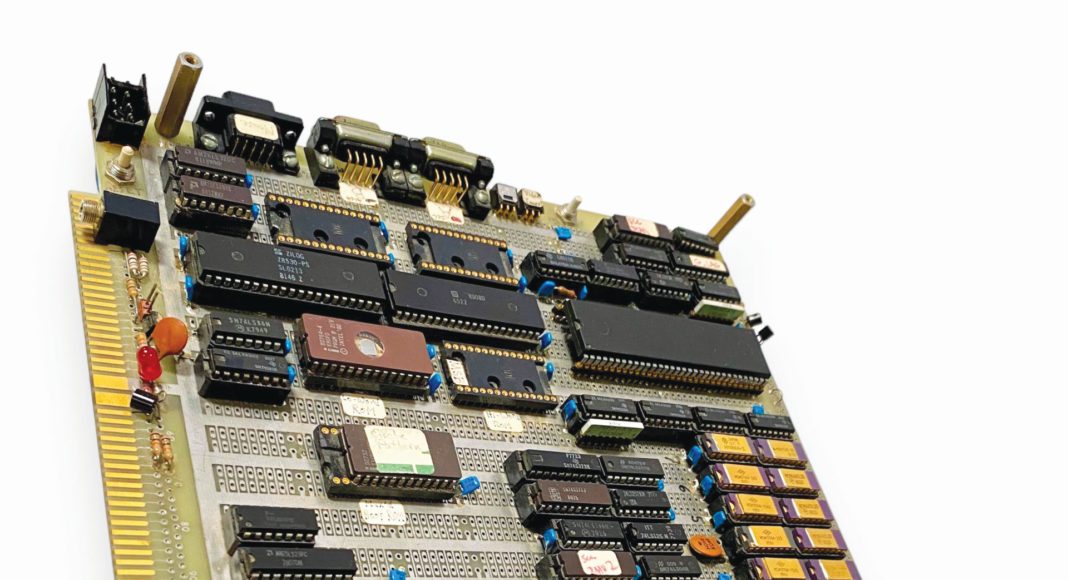As the Apple Macintosh officially turns 40, the Computer History Museum in Mountain View has installed a small pop-up exhibit to prepare for a rocking anniversary party on January 24th.
Several heroes from the original development team will attend the party.
On a recent visit to the exhibit, I saw among other items a wire-wrap Mac prototype from the original days, plus Andy Herzfeld’s business card—“Software Wizard” it said—and also a replica of the infamous pirate flag. Even though the exhibit was just a small selection of stuff, the grand sweep of history became unavoidable. The ghosts were lurking.
In 1984, a goofy 29-year-old named Steve Jobs unveiled the Mac onstage in the Flint Center, with the Chariots of Fire theme churning in the background. The crowd screamed in response. That presentation essentially invented the ground it walked on, defining the entire next generation of the product launch as a rock-star event. The PC industry was never the same afterward.
In 2014, Dan Kottke and several others threw together a gargantuan party for the Macintosh 30th anniversary, shelling out a fortune to rent the Flint Center just for the occasion. Most of the people who designed the original Mac—those who built it, wrote the software and/or created the ads—attended the party, along with journalists John Markoff and Steven Levy, who moderated panel sessions. Bill Atkinson told stories about the origins of MacPaint, which he created. Randy Wigginton, who created MacWrite, likewise told numerous tales. All of them quipped that it took thousands of Microsoft employees to replicate what 125 Apple folks originally created right here in Silicon Valley.
The highlight of that night was all of us sitting there in the Flint Center seats and watching a projection of Jobs’ original 1984 Mac product launch, which had originally unfolded on that same stage. It was eerie. Time did not exist at this 30th anniversary party. All that quasi-Tao of Physics hooey about spacetime continuum-shattering reality distortion zones, well, that night it was all going on. All of it.
Decades earlier, when Kottke drifted around India with Steve Jobs, the latter carried a copy of Jack Kerouac’s Dharma Bums in his duffel bag. They apparently ingested enough wisdom to later shape the entire course of the computer industry.
Jobs’ 1984 presentation has been on YouTube for years now, but a slightly different version is currently on display at the Computer History Museum. You will have to watch for yourself. I won’t spoil it.
Unfortunately, the Flint Center officially closed in 2019 and is slated to be smashed and replaced with a new building of whatever sort. Nobody wanted to pay for its modernization. You’d think with all the Cult of Mac wealth in this valley, somebody somewhere would fork over the cash to immortalize the exact spot where that presentation took place.
But I digress.
There was no way for me to stand there at the Macintosh 40th anniversary pop-up exhibit without contemplating the entirety of Silicon Valley history, especially in that exact neighborhood, in that particular building, which used to be a Silicon Graphics complex back in the 1990s. (That would be UNIX, for the non-grizzled in my readership.)
Going back to 1984, though, the MTV era was in full swing, meaning, it was still mostly music videos all day and night, unlike now. Bill Graham and the Grateful Dead’s Jerry Garcia were just starting to imagine Shoreline Amphitheatre, which opened in 1986 on top of a former city dump, just up the street from where the Computer History Museum now sits.
This particular part of Silicon Valley was vastly different in those days. There was no Google and no cell phones. Barely any technology had pictures on it. Tower Records still existed, pieces of farmland remained in Mountain View, and southbound Highway 85 ended at Stevens Creek. Then the Macintosh came along and changed the entire world.
Included in the pop-up exhibit is a replica of the pirate flag flown by the development team over Bandley 3, the Macintosh building at Apple, for more than a year to symbolize their counterculture attitude. They all firmly believed their work would eventually revolutionize the personal computing industry.
They were right.
Hello: The Apple Mac @ 40
computerhistory.org/exhibits/hello-the-mac-at-40/
Now through Feb. 25
Wed–Sun, 10am–5pm
Computer History Museum
1401 N Shoreline Blvd, Mountain View



